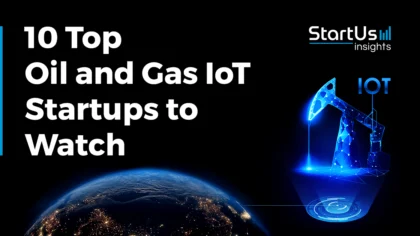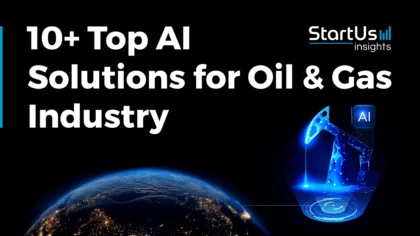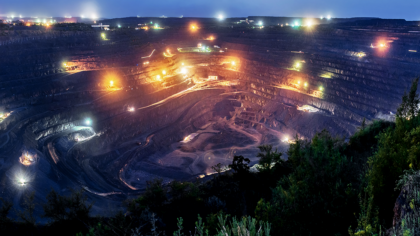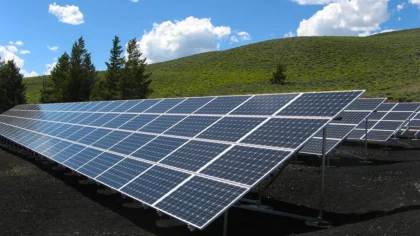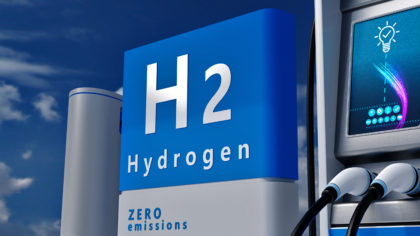Accelerate Productivity in 2025
Reignite Growth Despite the Global Slowdown
The Mining Industry Outlook 2025 records the mining industry’s evolution, where technological innovation and operational intelligence advance the sector from the ground up. Emerging trends such as advanced equipment, transport logistics, and worker safety are gaining momentum. This growth is driven by increasing automation and the integration of real-time analytics.
Moreover, the sector sees a surge in startup activity, particularly in areas like microbial extraction, AI-based fleet management, and lithium recovery. As companies across key global hubs double down on digital tools, sustainable practices, and strategic collaboration, the industry moves closer to redefining its role in the global economy.
Executive Summary: Mining Industry Outlook 2025
- Industry Growth Overview: The mining industry is projected to increase from USD 2.4 trillion in 2025 to USD 3.0 trillion in 2029, with a compound annual growth rate (CAGR) of 5.7%. According to our Discovery Platform, the sector grew by 0.30% in the past year.
- Manpower & Employment Growth: The sector employs 11.5 million people and added 498 600 new jobs in the last year.
- Patents & Grants: About 88 230 unique applicants filed for a total of 257 341, with a 6.62% YoY increase. China (77 443) and the USA (69 304) lead global patent activity. Over 4965 companies received grants for research, innovation, and operational upgrades.
- Global Footprint: Top country hubs include the USA, China, India, Australia, and Canada. Leading innovation cities are Perth, Vancouver, Sydney, Brisbane, and Johannesburg.
- Investment Landscape: Our database recorded over 20 980 funding rounds with an average deal size of USD 49.6 million. More than 11 800 investors funded 6678 companies.
- Top Investors: Some of the top investors include European Investment Bank, US Department of Energy, Japan Bank for International Cooperation, Sumitomo Mitsui Banking, and Orion Resource Partners. Together, the investors invested over USD 24.6 billion.
- Startup Ecosystem: Five innovative startups that showcase global entrepreneurial energy include 1849 Bio (microbial copper extraction solution), EYEMINE (asset performance software solutions), Geopyora (rock breakage characterization test), Stormlands Mining (Predictive Analytics Software), and XtraLit (direct lithium extraction).
Methodology: How we created this Mining Industry Report
This report is based on proprietary data from our AI-powered StartUs Insights Discovery Platform, which tracks 7 million global companies, 20K+ technologies and trends as well as 150M patents, news articles and market reports. This data includes detailed firmographic insights into approximately 7 million startups, scaleups, and tech companies. Leveraging this exhaustive database, we provide actionable insights for startup scouting, trend discovery, and technology landscaping.
For this report, we focused on the evolution of mining over the past 5 years, utilizing our platform’s trend intelligence feature. Key data points analyzed include:
- Total Companies working in the sector
- News Coverage and Annual Growth
- Market Maturity and Patents
- Global Search Volume & Growth
- Funding Activity and Top Countries
- Subtrends within mining
Our data is refreshed regularly, enabling trend comparisons for deeper insights into their relative impact and importance.
Additionally, we reviewed trusted external resources to supplement our findings with broader market data and predictions, ensuring a reliable and comprehensive overview of the mining market.
What Data is used to create this Mining Market Report?
Based on data provided by the StartUs Insights Discovery Platform, we observe that the mining market stands out in the following categories relative to the 20K+ technologies and trends we track.
These categories provide a comprehensive overview of the market’s key metrics and inform the future direction of the market.
- News Coverage & Publications: Over 55 198 news and articles were published about the mining sector in the last year.
- Funding Rounds: Our database showcases 20 989 funding rounds closed.
- Manpower: The industry employs more than 11.5 million people, with 498 600 new jobs added in the last year alone.
- Patents: More than 257 341 technologies in the industry have received patents.
- Grants: Over 4965 grants were awarded to the companies to advance operations and technology.
- Yearly Global Search Growth: It reached 10.13%, which reflects rising awareness and relevance.
Explore the Data-driven Mining Outlook for 2025
The mining sector continues to evolve with steady innovation and workforce expansion, as reflected in this heatmap analysis. Our database on mining includes 73 447 companies, with 2621 active startups contributing to new developments across the value chain globally.
Over the past year, the industry grew by 0.30%, supported by the addition of 498 600 new employees. This brought the total global mining workforce to approximately 11.5 million.
Innovation remains a core focus, with 257 341 patents and 4965 grants recorded. It indicates sustained investment in technology and process improvements.
Key geographic hubs driving this activity include the USA, Australia, Canada, India, and China. Perth, Vancouver, Sydney, Brisbane, and Johannesburg emerge as the leading city-level clusters.
A Snapshot of the Global Mining Market
The mining industry outlook shows the sector advancement with an annual growth rate of 0.3%. The market is projected to increase to USD 2.4 trillion in 2025. By 2029, it is expected to reach USD 3.0 trillion, with a CAGR of 5.7%.
71% of mining companies believe robotics and automation will have the most significant impact on the future of mining, overtaking AI in importance.
Market projections show that the autonomous mining equipment sector is expected to grow from USD 3.1 billion to USD 6.2 billion by 2026. In response, companies are increasingly deploying fleets of driverless trucks and robotic drilling systems.
Mining companies have increased their digital investments by 25%, acknowledging the role of digital tools in driving operational efficiency and reducing costs.
Credit: PwC
From 2019 to 2023, offsite mining costs saw a rise of over 40%, followed by energy and reagents with increases of around 35%. Inflation-driven costs climbed nearly 25%, while labor costs rose to just above 15%.
Credit: McKinsey
In 2023, metals and mining contributed around 15% of global emissions. By 2035, this share is expected to drop to 13%, reflecting a 15% decline in total industry emissions.
Reflecting this, the green mining market is projected to reach USD 16 billion by 2030. With environmental regulations tightening, the global mining industry will require more sustainable mineral production solutions.
The demand for minerals critical to clean energy is expected to nearly triple by 2030 and quadruple by 2040. By then, energy transition minerals are projected to generate 1.5 times more revenue than coal.
Further, our global startup database tracks 2621 startups, including 1435 early-stage ventures.
On the intellectual property (IP) front, the mining sector demonstrates innovation, with 257 341 patents filed by 88 231 unique applicants. This activity reflects a 6.62% year-over-year increase in patent filings and points to consistent R&D engagement.
China and the USA lead in patent issuance, with 77 443 and 69 304 patents, respectively.
Explore the Funding Landscape of the Mining Market
The mining industry closed over 20 989 funding rounds, with an average investment value of USD 49.6 million per round. More than 11 800 investors support these investments.
To date, these investors backed over 6670 companies that highlight the sector’s appeal and the growing alignment between capital markets and resource-driven innovation.
In 2023, the global mining industry faced declining revenues, down over 7% due to falling commodity prices and rising costs, despite higher production.
Credit: McKinsey
From 2020 to 2023, the materials industry saw revenues rise by USD 2.4 trillion, over 40%, driven largely by metals and mining, which jumped 75% to USD 1.7 trillion.
Earnings Before Interest, Taxes, Depreciation, and Amortization (EBITDA) in metals and mining nearly doubled, from USD 500 billion to USD 900 billion.
Net debt-to-EBITDA ratios stand at 1.3 times, below the 1.8 times average, giving firms greater investment flexibility.
Additionally, the industry saw 3102 mergers and acquisitions (M&A) that highlight the ongoing consolidation and strategic investments. M&A involving critical minerals like copper and lithium rose to 40% in 2023, a jump from 22% in 2019.
Uranium’s spot price jumped from under USD 50 per pound in 2022 to over USD 100 per pound by early 2024.
Likewise, anticipated investment in mining critical minerals between 2022 and 2030 reaches USD 180-220 billion. Other Asia Pacific accounts for around 40%, Central and South America for 20%, while China, Europe, Africa, and North America contribute 5-10% each. The remaining share comes from the rest of the world.
Between 2019 and 2023, critical minerals transaction value peaked at around USD 22 billion in 2022 before falling to USD 16 billion in 2023. Lithium and copper led deal volumes, with lithium accounting for over 30% in 2022.
The number of mining deals declined from a high of about 1300 deals in 2021 to roughly 1000 in 2023. However, the total deal value rose from USD 50 billion in 2020 to nearly USD 70 billion in 2023, which highlights the change toward fewer, higher-value transactions.
Who is Investing in the Mining Market?
The mining industry secured backing from major financial institutions and strategic investors. The top investors collectively deployed over USD 24 billion across the sector. This reflects strong confidence in mining’s long-term value and strategic importance in the global economy. Key contributors include:
- The European Investment Bank invested USD 3.4 billion across 8 companies.
- The US Department of Energy backed 9 companies with a total of USD 3.3 billion.
- Japan Bank for International Cooperation invested USD 3.1 billion in 6 companies.
- Sumitomo Mitsui Banking supported 11 companies with USD 2.8 billion.
- Orion Resource Partners stands out with USD 2.4 billion invested across 33 companies.
- KKR deployed USD 2.2 billion into 5 companies.
- Glencore invested USD 1.9 billion in 18 companies.
- Goldman Sachs invested USD 1.9 billion across 10 companies.
- Export Development Canada supported 10 companies with USD 1.8 billion.
- The Export Import Bank of the United States committed USD 1.8 billion to 5 companies.
Top Mining Innovations & Trends
Discover the emerging trends in the mining market along with their firmographic details:
- Mining Equipment domain is expanding rapidly. It holds an annual growth rate of 6.81%. This sector includes 3431 companies employing 539 200 people, with 25 400 new employees added in the past year. It reflects continued demand for automation, machinery upgrades, and operational scaling.
- Mining Transport remains essential to moving raw materials efficiently. It shows an annual growth rate of 1.15%. The segment features 458 companies and a workforce of 95 000 employees, with 2800 positions added over the last year.
- Mining Safety gained momentum with an annual growth rate of 8.69%. It involves 272 companies that employ 34 300 individuals, including 1000 recent hires. This domain reflects increased prioritization of worker well-being, risk management systems, and regulatory compliance.
5 Top Examples from 2600+ Innovative Mining Startups
The five innovative startups showcased below are picked based on data including the trend they operate within and their relevance, founding year, funding status, and more. Book a demo to find promising startups, emerging trends, or industry data specific to your company’s needs and objectives.
1849 Bio offers a Microbial Copper Extraction Solution
US-based startup 1849 Bio develops custom-engineered microbes that extract copper from low-grade ores. The startup analyzes ore samples to map their microbiome and mineral composition. Its bioengineering platform enhances naturally occurring microbes with traits tailored to the target ore.
Further, the startup validates these strains through high-throughput screening to ensure high extraction performance. This is followed by deployment within the mine’s existing leaching infrastructure. This way, the startup offers a biotech alternative to traditional extraction methods.
EYEMINE builds an Asset Performance Software Solution
Australian startup EYEMINE builds real-time data platform solutions that enhance load and haul operations using integrated internet of things (IoT) and artificial intelligence (AI) technologies.
The startup’s EYE-ANALYSE platform automates data ingestion from multiple sources, applies machine learning models, and visualises machinery and fleet metrics on a single dashboard. Complementing this, the EYE-WEIGH system provides modular truck weigh scales that reduce underloading, overloading, and associated equipment strain.
In parallel, EYE-SCAN uses non-contact laser scanning to calculate volumetric load profiles in real time. This simplifies truck payload management with ongoing monitoring and validation.
Moreover, the EYE-TALPA functions as an AI-based data logging platform that leverages asset-specific models to track fuel usage, idle time, and maintenance triggers. It ensures timely interventions and reduces operational risk. Altogether, EYEMINE improves asset performance, cuts costs, and increases productivity.
Geopyora provides the Rock Breakage Characterization Test
Finnish startup Geopyora offers a rock breakage characterization test that provides comminution parameters for mining and mineral processing applications. The test uses counter-rotating wheels to apply controlled compressive force on small rock samples.
Further, it records both energy consumption and breakage response in real time. Also, it enables continuous automated feeding of rocks and captures measurements for each breakage event. This includes the drop weight index, bond ball mill work index, and axb values.
Additionally, Geopyora calculates specific comminution energy for each particle and performs t10 analysis through post-breakage sieving. By integrating machine learning and energy-based testing, the startup enables cost-effective, high-throughput analysis.
This supports geometallurgical modeling, comminution circuit design, and operational control with minimal material requirements and high data accuracy.
Stormlands Mining makes a Predictive Analytics Software
Irish startup Stormlands Mining develops data analytics software that creates a digital twin of the mine to track real-time performance. The software’s dashboards consolidate historical and live data to provide reporting across mining production, ore treatment, engineering, health and safety, and environmental impact.
Additionally, it enables scenario modeling and outcome forecasting by applying predictive analytics to operational data. This supports decisions like planned maintenance and energy optimization. Through tailored visualizations and alerts, the platform aligns with specific operational roles and improves overall data management.
XtraLit simplifies Direct Lithium Extraction (DLE)
Israeli startup XtraLit builds a direct lithium extraction technology that enables the recovery of lithium from low and medium-concentration brines. The process is based on a sorbent material that uses ion exchange to separate lithium in a controlled cycle of absorption and desorption.
The extraction begins when brine comes into contact with RH, an ion exchanger in its hydrogen form. This material captures lithium ions while releasing hydrogen. The lithium-bound exchanger (RLi) is then rinsed with water to remove any remaining brine.
In the final stage, an acid treatment releases lithium from the RLI, returning it to its original RH state and producing a concentrated lithium solution. This closed-loop system reduces land and water usage and aids in lowering both capital and operational costs.
Gain Comprehensive Insights into Mining Trends, Startups, and Technologies
The data in this mining report 2025 reflects an industry actively transitioning into an adaptive and future-ready sector. Companies adopt new technologies while aligning their operations with broader goals around efficiency, safety, and environmental responsibility.
From digitized workflows to predictive analytics and clean resource extraction, the sector includes innovations that enable smarter decision-making and long-term resilience. This transformation accelerates the growing presence of agile startups offering focused solutions to longstanding challenges.
Get in touch to explore 2600+ startups and scaleups, as well as all market trends impacting mining companies.


